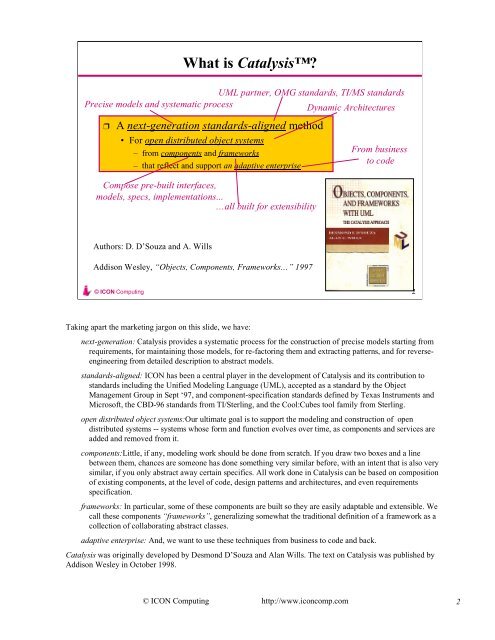Objects, Components, and Frameworks with UML The Catalysis ...
Objects, Components, and Frameworks with UML The Catalysis ...
Objects, Components, and Frameworks with UML The Catalysis ...
Create successful ePaper yourself
Turn your PDF publications into a flip-book with our unique Google optimized e-Paper software.
© ICON Computing<br />
What is <strong>Catalysis</strong>?<br />
<strong>UML</strong> partner, OMG st<strong>and</strong>ards, TI/MS st<strong>and</strong>ards<br />
Precise models <strong>and</strong> systematic process<br />
Dynamic Architectures<br />
❒ A next-generation st<strong>and</strong>ards-aligned method<br />
• For open distributed object systems<br />
–from components <strong>and</strong> frameworks<br />
–that reflect <strong>and</strong> support an adaptive enterprise<br />
Compose pre-built interfaces,<br />
models, specs, implementations...<br />
…all built for extensibility<br />
Authors: D. D’Souza <strong>and</strong> A. Wills<br />
Addison Wesley, “<strong>Objects</strong>, <strong>Components</strong>, <strong>Frameworks</strong>…” 1997<br />
Taking apart the marketing jargon on this slide, we have:<br />
© ICON Computing http://www.iconcomp.com<br />
From business<br />
to code<br />
next-generation: <strong>Catalysis</strong> provides a systematic process for the construction of precise models starting from<br />
requirements, for maintaining those models, for re-factoring them <strong>and</strong> extracting patterns, <strong>and</strong> for reverseengineering<br />
from detailed description to abstract models.<br />
st<strong>and</strong>ards-aligned: ICON has been a central player in the development of <strong>Catalysis</strong> <strong>and</strong> its contribution to<br />
st<strong>and</strong>ards including the Unified Modeling Language (<strong>UML</strong>), accepted as a st<strong>and</strong>ard by the Object<br />
Management Group in Sept ‘97, <strong>and</strong> component-specification st<strong>and</strong>ards defined by Texas Instruments <strong>and</strong><br />
Microsoft, the CBD-96 st<strong>and</strong>ards from TI/Sterling, <strong>and</strong> the Cool:Cubes tool family from Sterling.<br />
open distributed object systems:Our ultimate goal is to support the modeling <strong>and</strong> construction of open<br />
distributed systems -- systems whose form <strong>and</strong> function evolves over time, as components <strong>and</strong> services are<br />
added <strong>and</strong> removed from it.<br />
components:Little, if any, modeling work should be done from scratch. If you draw two boxes <strong>and</strong> a line<br />
between them, chances are someone has done something very similar before, <strong>with</strong> an intent that is also very<br />
similar, if you only abstract away certain specifics. All work done in <strong>Catalysis</strong> can be based on composition<br />
of existing components, at the level of code, design patterns <strong>and</strong> architectures, <strong>and</strong> even requirements<br />
specification.<br />
frameworks: In particular, some of these components are built so they are easily adaptable <strong>and</strong> extensible. We<br />
call these components “frameworks”, generalizing somewhat the traditional definition of a framework as a<br />
collection of collaborating abstract classes.<br />
adaptive enterprise: And, we want to use these techniques from business to code <strong>and</strong> back.<br />
<strong>Catalysis</strong> was originally developed by Desmond D’Souza <strong>and</strong> Alan Wills. <strong>The</strong> text on <strong>Catalysis</strong> was published by<br />
Addison Wesley in October 1998.<br />
2<br />
2


